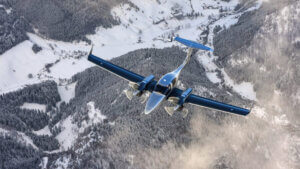CAV Ice Protection Limited has filed for a patent for an anti-icing solution for small uncrewed aerial systems (sUAS) that it claims could revolutionise commercial drone use in cold climates.
Engineers at the County Durham based manufacturer, which is part of the CAV Systems Group, designed a concept ice protection system (IPS) that prevents ice from building up on the rotor blades of a drone or sUAS. The company is now looking to bring the technology solution to market.
conditions is crucial – especially as the market is changing from being centred on hobbyists and the defence industry to wider sectors, such as medical, retail and logistics.
Alex Baty, CAV Systems’ VP of Engineering, said: “This is an industry first, nobody has previously demonstrated an ice protection system that works for this size of aircraft, and we’re not aware that anybody else is working on one.
“We’re ahead of the curve in that respect and it has attracted the attention of some major distributors. We know that, globally the use of drones for last mile delivery is already in action. We hope that our anti-icing system can help to tackle a significant obstacle to widespread drone usage.
“Our testing has seen the effects of icing on a propeller will cause a 50% reduction in lift generation after just three minutes, which underlines the impact that icing can have on sUAS.
“If sUAS-based product delivery is to move forward, and become viable across a range of geographical locations, then ice-protection will need to be factored in, in order to guarantee safe, efficient and reliable flying.
“There are some potential niche applications as well: the idea has been explored of using sUAS to launch flares that would seed clouds with silver oxide particles for weather modification.
Imagine being able to use unmanned aircraft to remove freezing fog conditions around an airport.”
CAV Systems’ solution works by distributing freezing-point depressant fluid across the leading edges of a carbon-fibre blade that is typical to smaller aircraft.
Testing of the system began with a single 18” diameter motor and propeller assembly and progressed to an Octocopter. Further tests using models with and without the IPS in an icing wind tunnel to emulate freezing conditions also secured positive results.
During these tests, the application of the CAV IPS to the propeller saw lift of the model reduce by as little as 10% with small changes to power, compared to the build-up of ice, causing a 50% reduction of ice and doubling of electrical power consumption without the ice protection in place.
Weight is a critical factor: engineers at CAV Systems have brought the weight of the full Octocopter system, including fluid storage, to below 2kg. This figure is around 20% of the total payload of the test model, and the engineers believe this can be brought down by another 25% depending on the aircraft’s total flight plan by further system optimisation.
Baty added: “The work we have done, and are continuing to do, around weight reduction will have a huge bearing on the solution. When a drone has a payload of around 10kg, 500g is a significant percentage.”
A live icing flight test is scheduled to commence in March in Colorado in association with a major regulatory body.






